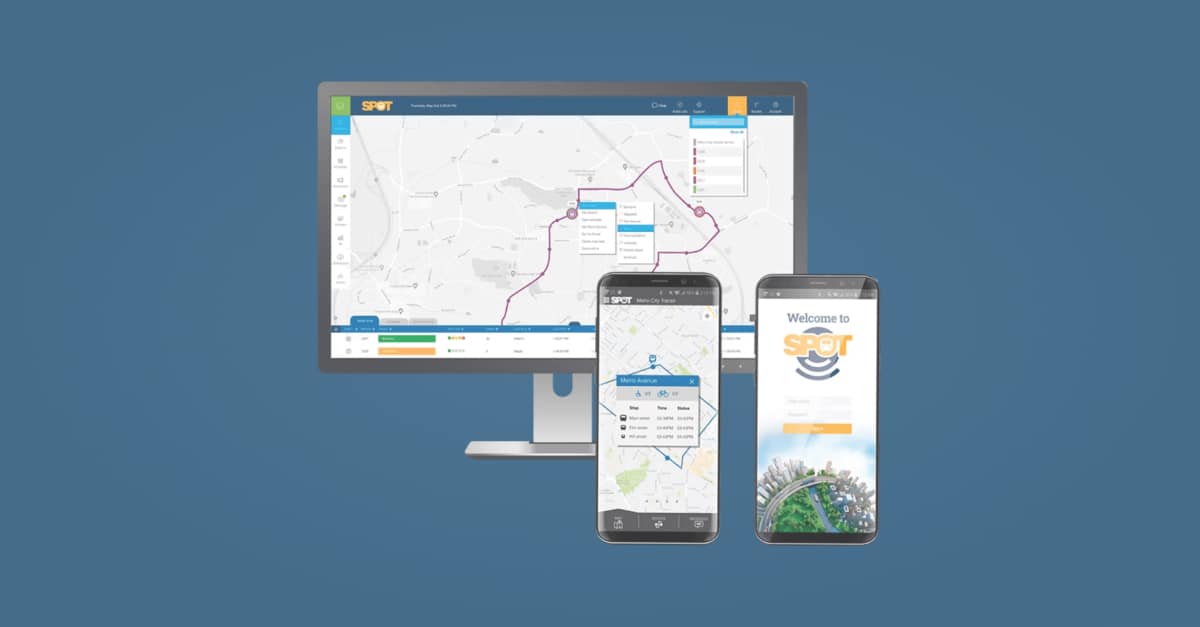Stop Requested. Welcome to Stop Requested, the podcast where we discuss everything transit. I’m your host, Christian Londono, Senior Customer Success Manager at ETA Transit. And I believe I’m a column Product Manager at ETA Transit.
How’s it going, Christian? Good, good, good. How’s it going with you, Levi? Yeah, going pretty well. Excited for today’s discussion. Listen, today’s discussion, I’m very excited because it’s a topic that is growing in popularity.
I have more customers of ours at ETA Transit that are calling me asking about this specific topic. And the topic is APC recertification in 2025, reporting year 2025, as a requirement now by the FTA. And, of course, APC recertification or certification.
To start a conversation, I think the most important piece is start by defining APC. And we just said this acronym, and there might be some of the people out there listening that are familiar with it, and there might be some that are not.
So how about, Levi, you tell us what this acronym stands for, and also tell me a little bit about what you think, why is this requirement important for agencies to get acquainted with or get up to speed with what it is and what it requires?
Sure, absolutely, Christian. Yeah, for those who don’t know what APC stands for, it’s automatic passenger counter. And I could really nerd out about this stuff. It’s a lot of fun to talk through all the nuances and different use cases of APC certification.
And importantly, for those agencies that are already certified, as you mentioned, next year 2025 is a recertification year. That’s key. If you want to make sure that your APCs are in good shape, and you’re still able to report that data to the NTD, you’ll want to get recertified.
Otherwise, you have to fall back to a different method to be able to estimate your average passenger trip length, and that can be pretty time -consuming. I know from personal experience that doing those 100 -plus trips every year, or maybe more if you’re a larger agency, can really bring you down.
So you want to use your resources wisely. You have to review fewer trips, compare those APCs to the manual accounts. That’s a much easier hurdle to overcome rather than having to survey 150 trips and do all that manual accounting.
So I really recommend agencies to get APC certified if you have the APCs. And of course, if you’re already certified, then you really want to stick with that course. and follow the 2025 recertification timeline.
That is mandatory. The other thing is that the window for starting the process is opening up very soon. A lot of the agency’s fiscal year is about to end, meaning the new one about to start, and the certification is required for reporting year 2025.
With that start of the new fiscal year, which will be fiscal year 2025, those agencies, that’s when the clock starts ticking. They’re able to start the certification as early as last quarter of 2024.
Right. Well, some agencies may have already started their 2025 fiscal year, and if that aligns with the reporting year, all agencies kind of shake out a little bit differently here, but for those that have a July to June reporting year, then they could already start on this and go ahead and spend that four weeks, six weeks, and survey all the trips that they need, submit their package over to the NTD,
and you’re good to go unless there are any hiccups along the way, or the FTA has any feedback about the trips that you submitted. But I recommend starting as soon as possible. Yeah, completing the trips can be very much time consuming.
And like you said, if you’re waiting for last minute, and for whichever reason, your sample is not good, or it’s not within the certification criteria, in terms of error, or if you have some faulty APCs, you need time to be able to fix those and potentially take a new sample that will get you certified.
So starting early is certainly a great advice for everybody out there that is planning for this process in 2025. I want to talk to you a little bit more about the importance of the certification. So recertification, 100% of these agencies, it seems that they knew the importance of achieving that original certification, but they’re required to retain the certification.
But I want to talk to you about the importance. So why is it important to certify the APCs? What are some of the benefits that you could see for an agency that’s never been certified and is now considering achieving that certification?
I think the barrier to entry for APC certification is lower than it used to be. When we were using infrared sensors atop the door of the transit vehicle, that technology, while good at the time, doesn’t muster up in comparison to Let’s say the optical technology that most APCs I would say are made of today and It’s important to be able to use those APCs so you can get the boarding and a lighting count if you’re with the if you’re using the traditional fare box methodology,
Then you’re only getting those boardings and The lightings are equally as important, you know You need to know what your load is where and where that load is in the course of the trip It’s also important to be able to break that down at a more granular level so you can see it at a stop base level Not only you know, what is my load at the time, but who’s getting on where and who’s getting off where?
Right. That’s not so obvious to To the transit agency if you don’t have the APC data What I’m hearing not only it gives you more data Insight right is giving you that data inference is giving you more information about the ridership behavior In ridership in terms of how many people right how many passengers are boarding the vehicles and using the service?
It’s one of the most important metrics for transit agencies. So not only being able to have this very important data in a manner that is accurate, right if you have certified APCs, it means that They’re reading correctly.
They’re counting correctly and they’re counting all the time So you have all these very important data, but it’s also correct because you were certified. So that has a level of accuracy confidence But it also allows you to plan around this data.
So so some of the things that come to my mind Is a service evaluating the service how useful it is how productive it is And i’m also thinking about amenities if you are looking to Find locations where you want to prioritize for bus shelters and you got this grant and you have funds for maybe 30, 40 more shelters.
You’re going to look at locations with no shelters, but it has the most boardings. There’s a lot of people waiting. Maybe the headways are 30 minutes, and you have people waiting for a good amount of time.
It’s a good candidate for shelter. So having this information, it’s certainly very important, but also operational efficiency. So if you’re not certified and your agency, let’s say, is a mid -size agency, most likely every other day, the agency has to have surveyors going out and collecting accounts to be able to report their average passenger trip length.
Levi, you’re familiar with that process? Could you explain that process and how it works a little more? Yeah, absolutely. So this is something that I was directly responsible for when I was working at my first transit agency here in Florida.
The process is fairly straightforward, but there are a series of steps. So the first thing that you have to do is be able to randomly select trips from your system, and you have to do that by service change.
So you break down, you know, trips to survey maybe a couple every other day. You can spread it out a little bit more evenly if you’d like and do some every day. And, you know, really, you can make up your own methodology as long as a certified statistician is or a mathematician is willing to sign off on it.
But you’re then selecting those trips, either going out on the bus with pen and paper and clipboard, or, you know, you’re watching the video from maybe your surveillance system that you have on the bus.
A lot of agencies are moving to that technology now to save a little bit of time, you know, get the footage from the vehicle’s hard drive, and, you know, go back into the office and watch it in the comfort of the office and be able to pause and fast forward, rewind all those great things.
You’re then putting in the boarding and alighting data, and you have to be able to figure out, on average, how long is a person staying on your bus. Now, with the types of technologies that are on a bus or even a train, you know, it is difficult nowadays still to be able to determine if, you know, Christian was actually that person that got on at that stop, and then Christian got off at that stop.
It’s not really how it works. So, most of the time, agencies are using a load -based methodology to figure out, well, we had this many people on the bus at this time traveling this bus. this distance and you come up with an average distance that you then multiply at the end of the year for your S10, that annual form that you submit to the NTD, you’re going to say, well, we had 5 million passenger trips,
unlinked passenger trips at the end of the year over the whole 12 months. And based on our average passenger trip link survey that we did for the course of the year, the average passenger is traveling about five miles on board one of our buses.
So you would multiply the 5 million by five, the five miles, that is, and you get 25 million passenger trips. Excuse me. Then you would get 25 million passenger miles. And that’s what you would report to the national transit database.
So based on your explanation, all this is a statistical estimate. Notta Notta and based on the methodology approved by the FDA, that is in the NTD policy manual, that estimate following the methodology should be a good reflection of the service consumed at your agency, but still is an estimate.
So knowing that the numbers reported by transit agencies to the NTD, especially passenger miles and some of the metrics we’re discussing, are part of the calculation or for the distribution of federal funds for the funding formula, you could or agencies could be leaving money at the table by estimated versus reporting actual versus using 100% counts and reporting actual miles.
Would that be a correct statement based on what you heard or what you know? Yeah, agencies could be leaving money on the table if they’re not counting correctly. Fair boxes are known to undercount. I think that is, in my experience, that’s mostly what happens when you’re comparing your fair box counts to your APCs.
I have heard of other cases where the APCs have undercounted, but by and large, I think it’s the reverse. So if you’re using your APCs to be able to report your unlinked passenger trips, then you’re ensuring that you’re going to get higher unlinked passenger trips, or at least putting yourself in the best position to get the maximum unlinked passenger trips possible.
And I think to cap it all off, you don’t have to do that average passenger trip link survey any longer because your APCs, along with your CAD AVL system, are going to give you your loads in between the stops.
So you’ll be able to multiply the distance traveled. you know that is all taking place kind of behind the scenes for you and it’s much less of a burden to be able to get APC certified than it is to do the average passenger trip link survey especially if you’re a large agency.
If you’re a mid -size or a mid or a large agency a hundred percent agree and I was part in my you know one of my previous positions of my career in transit of an agency where I had to help capturing the trips and have to be on a bus every you know two three days capturing two three trips a day and it would take a lot of my time as a transit planner doing these.
A. Very tedious and it’s an ongoing process, like almost every week you’re capturing trips and they could, for a mid -size agency, you could be tallying up at the end of the year close to 600 -700 surveys that you have to complete.
And to your point, they have to be completed during the service period, right? Like if you have service changes four times a year, you have to complete a certain amount of surveys within that service period.
You cannot just do all the surveys rush to do them at the end of the year and then trying to do 600 surveys as quick as you can because you’re trying to submit to the NTD. You’re supposed to be working on this actively throughout the year.
So it’s certainly an operational deficiency or inefficiency, right? When you’re doing all this ongoing, all these trips and not be APC certified, so able to use the system and potentially use a more accurate data.
So I want to move the conversation to the components. What are the key components of the APC certification? APC certification, what are those things that typically agencies that are getting certified have to complete?
And I want to start by sharing my experience working on an APC certification project from the first certification. And then I want to hear about your experience dealing with APC certification. But I’ll tell you, Levi, there’s three buckets.
I would say three categories, in my opinion, that are important to keep in mind. One is to understand the technical standards, all the requirements for the process in terms of what’s the margin of error, what’s the metrics and the data that I have to collect, how’s the sample size, and how is it going to be put together to be a good reflection.
section of my system. These are some of the details. What APC manufacturer do I have and what are the specifications of my sensor? So all these things are very important to keep in mind as you’re embarking in that process.
The second thing is testing and evaluation and is looking at how you’re going to first assess the condition of your APCs. What I’ve seen happening out there is that agencies that have APCs but have never attempted to certify them, they’re not keeping a pulse of the accuracy of the data in which vehicles are accounting well, which vehicles might have deficient APCs that they need to troubleshoot.
So the first thing is to make that assessment, to then be able to move into the process of okay, now I know which ones, you know, maybe everything is running correctly and all your sensors are on point and that’s a great position to be.
But sometimes when you’re starting this process, you’re starting with out of 100 buses, 20 or 30 buses might not be counting correctly. So that’s the testing evaluation is knowing where you are at, fixing those issues, working with your ITS vendor.
Typically, it’s your county VL provider, the one that is assisting you with this process. And once you know that your APCs are counting right, then you start the sampling process. So that’s the next piece that leads me to the third bucket in terms of key components for certification, which is having your actual plan.
When are you planning to do it? How many trips do you have to complete? And what are the resources that are going to be involved with that process? Who’s going to be your project manager? Are you partnering with your ITS vendor?
And how are they involved? And once you have these plans in place, then you roll out and actually capture the samples and complete the entire process. So that’s in my perspective and opinion, what the key components for the certification process are and my experience doing it.
I want to ask you, what’s your experience or anything else you would want to add to what I just said? Well, I’d say that that was pretty comprehensive. And if I’m someone listening to this, and I’m a part of a planning department for a transit agency, I’m taking that advice, because I think it’s really solid.
And it’s going to give them a plan of action. It’s important to think the steps through to be strategic to make sure that you’re staying in regular contact with your NTD analyst, you don’t want to catch them by surprise and, you know, either miss deadlines or not communicate anything to them in advance.
Really, everyone in the agency needs to be a part of the APC certification. It’s important that you get your stakeholders together. And you describe to them what is going to be done what the time nline is, and I think you really hit the mark there when you said that there needs to be a point of contact.
Someone responsible as a project manager inside of the agency to ensure that each of these steps is being carried out. Because we’ve seen it, Christian, where agencies have started and stopped and started and stopped, and it takes a lot of energy to pick back up where you left off.
And there’s no guarantee that the NTD or your FTA individual that you’re speaking to is going to accept the data after a long period of time. So plan it out, think it through, create a bit of a roadmap for yourself, and make sure people are involved.
I think that having different stakeholders involved in the process is critical. A lot of the APC providers or CaddyVL vendors that provide the APC technology, they include features for pre -tripping or pre -trip inspection process for the APCs that have all kinds of different tests but generally require the driver to board and the bus and then get counts on the MDT to at least make sure that the counters are actually operating and if you get on and off multiple times through the rear door,
the front door, get count and the counts are looking well, like it’s actually counting the amount of times you board and light it, then you pass the test. So it’s important when you’re starting a process like this to look at all the different opportunities to assess the APCs and to let people know that we’re in the process of certifying our APCs.
So any concern, anything that has happened related to the APCs, they’re communicated to that project manager to make sure everyone is on the same page. Along with following these steps and understanding your technology, so the different sensors can be impacted by lighting conditions.
If you use an infrared sensor or even if you have cameras in low light or in a lot of light, they might not perform as well. So it’s important to understand that technology be able to capture trips at different times of the day that will be able to capture all those scenarios and make sure that the conditions.
But the process itself of capturing the trips has not changed a lot from what I recall in a doing this process maybe eight years ago. People get on a bus with a clipboard and maybe you have the entire list of stops.
Maybe you just have a column that is titled bus stop and then you’re supposed to pick up the number on the street and write it down. Some agencies have to manually capture after that the distances in between stops.
I mean it’s very tedious and even if you’re looking at footage and you’re not riding the bus is a process where there’s a lot of manual work on Microsoft suite. You know maybe you do some stuff in Excel, maybe you do take some notes on Word.
I want to know a little bit more Levi about this innovative product that ETA Transit has been working on to modernize the way people capture these trips, not just for the certification and recertification of APCs, but just for ongoing reporting.
So what can you tell us all about this innovative product and how is it different or how is it innovative and related to this APC recertification process? Yeah, thanks, Christian. Talley is born out of my own frustration.
That’s ETA Transit’s newest product. You know, Talley is really—let me restart that. I want to say it differently. I didn’t like that I said, yeah, Christian, or thanks, Christian. I don’t know why I said that.
Anyway, okay. Talley, ETA Transit’s newest product, is really born out of my own frustration. Doing the APTL, or the Average Passenger Trip Link Survey, back when I was a planner and then a senior planner and planning manager, I experienced the pain of getting on the bus or watching the video footage and making sure that all the Excel formulas were correct and gathering all these documents, making sure that the person who was going out on the bus that day and doing the surveys filled out all the forms correctly and then I had to re -transcribe them,
enter them into Excel, scan the form that they filled out, put that into a shared drive somewhere, make sure that no one deleted that so it was protected. There was a lot of headache around this whole process.
And agencies over time have kind of evolved to have their own special way of doing either the Average Passenger Trip Link Survey or even the APC Certification Surveys. And really, there should be a standard way of doing this.
And that was the idea behind Talley. take the black and white of what the NTD says that we’re supposed to do as transit agencies and let’s apply that to software. So the idea was really born out of that and Talley facilitates the collection of this data by giving you a more modern interface, right, rather than the pen and paper medium.
You’re using a tablet, you’re using a phone, you’re using a laptop or a desktop machine. You can access it from a browser, so anywhere, anytime. You don’t have to download anything. All you do is log in with an email address and the software just knows who you are and it will give you your agency’s information.
We’re pulling in the information that you’re already producing from your GTFS to be able to populate the trips, to get the surveys in a templated format and all you’re doing is interviewing the boarding and alighting data with the help of…
a visual aid in the form of a map. So we really feel like we’ve taken this from, wow, you have to start from ground zero every single time to we’re going to get you 70, 80% of the way there. Most of the heavy lifting is done for you.
The calculations are handled all in the backend. It’s a single click where you could get your report and either keep that in tally if you’d like, or if you want to export it and you still want to have your backups, that’s great.
We also support that as well. Tali supports that. Tali will enable you to be able to collect your data either on board the vehicle or remotely, so there’s no worrying about, you know, can I only do it one way or do I have to do it the way that Tali says?
No, it is very flexible in that regard. So we try to think of everything. Of course, it’s an evolving product since it’s very new and, you know, we’re looking to get people in as pilot users. So if you want to be a beta user, you know, please reach out to us.
Thank you, Levi, for that overview and it’s very exciting, I mean, because the way you’re describing it, you can ditch the clipboard, there’s no paper form and when you get off the bus, then you don’t have to make a report, right?
Like because the report is auto -generated for you with all the calculations. So I know that you cannot really get away from actually doing the visual inspections, that’s the whole process of certification is validating that whatever is computer generated through this APC is actually reflective of what happened in reality in that visual inspection, either by looking at footage or being physically on the vehicle,
there’s no getting out around that. But being able to. get off the bus and have the reports made where you don’t have to go back to your computer and build any reports. I think that’s a lot of time savings.
Looking at an agency, as I mentioned, some agencies, they have to complete up to 600, 700 service a year and all the time that they are spending today on making or building those reports, that could all go away by using Tali.
That’s certainly very exciting. Levi, where could somebody go today to learn more about Tali? Is there a site or somewhere where they can read on the functionality, features, and potentially get in touch with ETA Transit?
Absolutely. If any of the listeners out there would like to be beta users or would just like to learn more information about what Tali offers, then they can visit etatransit .com forward slash Tali and that will give you the overview of everything Tali.
If you want to contact us, there’s also a contact form on that page as well, and we’d be more than glad to jump on a call and talk you through it and see if it would work for you. Sounds good. Sounds good.
I think that a lot of folks should at least check it out. So I want to conclude our conversation this afternoon by kind of like summarizing some of the takeaways. I think that, you know, something that we said at the beginning is is the importance of the APC certification, especially on 2025 as an FDA requirement and making sure that we’re realizing the importance of this data and how useful it is for agencies to make decisions,
but also to streamline their processes, right? If they don’t have to be taking all these surveys ongoing as part of the reporting process and they can just rely on the data that is coming automatically from the passenger counters, that’s something that is 100 percent, you know, an efficiency that agencies should consider adding to their toolbox for 2025.
And I think the next thing has to do with improving the archaic methodology for capturing the surveys and potentially automating it using technology. Something like Tally as a planner and related to what you said, somebody that experienced the pain of capturing the surveys, it will be a blessing to be able to use a tool like this.
So thank you, Levi, for the conversation. I think that you provided a lot of insight related to this topic. Looking forward to our next conversation and the next topic, transit related. And I want to close thanking everybody for joining us and for listening to us today.

SPOT: ETA’s Core Platform The SPOT™ ecosystem offers transit management solutions by providing a flexible, modular platform.
All Solutions
CAD / AVL / GPS tracking
Business intelligence
Digital signs and kiosks
Infotainment
Automatic passenger counting
Tally NTD Survey Software
Tracking websites and apps
Vehicle announcements
Vehicle health monitoring (AVM)
Voice communication





